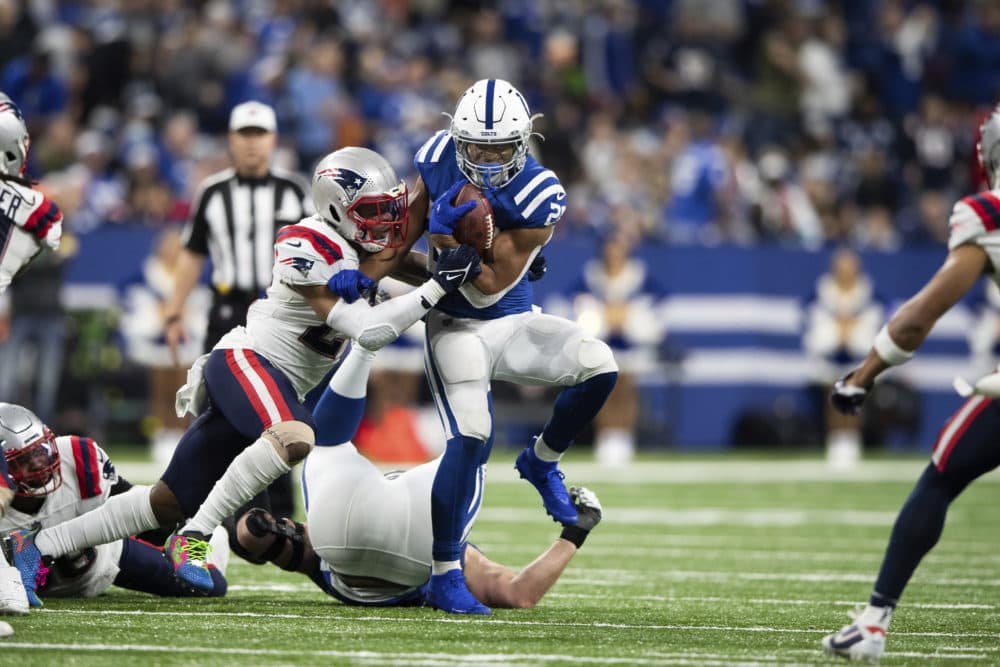Advertisement
Pro football players are 4 times more likely to die from ALS, study finds

Professional football players are four times more likely to develop ALS and die from the neurodegenerative disease than the general population. And the longer a person plays football, the higher the likelihood of developing ALS, which is also known as Lou Gehrig’s disease, according new research from Harvard Medical School, Boston University and several other institutions.
The new study, published in the journal JAMA Network Open, is the most comprehensive look at the incidence of ALS in football players to date. The study included every player in a professional football game between 1960 and 2019, or nearly 20,000 players. However, the implications of the findings reach far beyond athletics.
WBUR spoke with Daniel Daneshvar, one of the study’s authors as well as a professor at Harvard Medical School and a brain injury physician at Spaulding Rehabilitation Hospital, to learn more about the findings.
This interview has been edited for brevity and clarity.
Tell us about your study and the findings.
So, there's been a good deal of research looking at the long-term effects of repetitive head impacts. One of the findings is that repetitive head impacts, in some settings, might increase people's risk of developing ALS. We wanted to better understand this by looking at a group of people who are at risk of high exposure to repetitive head impacts. Namely, professional football players.
When we looked at every NFL player who played in at least a game, we found that they had a much higher risk of developing ALS, to the tune of a four times higher risk of both developing and dying from this disease.
We were certainly surprised by the strength of this relationship. There have been other studies looking at professional soccer players, military veterans and even some studies looking at a smaller group of professional football players. But none of them had looked in a group this large and still found such significant results.
One of the other interesting things that we found [is] that the folks who played football and developed ALS, they actually played professional football for significantly longer than the folks who played professional football and didn't develop ALS. For the folks who got ALS versus those who didn’t, we found an over 50% longer professional football career. No previous study has ever shown this.
Advertisement
What does this mean for people and how they behave in their personal lives?
Ninety percent of ALS cases are what we call sporadic, meaning we don't know what causes it. What this study suggests is that, for some subset of those sporadic cases, repetitive head impacts or concussion might actually increase your risk of developing ALS. So, there’s the possibility that there's an intervention or a mechanism that we can target to help these individuals.
Also, your brain doesn't care what hits it. This study is interesting for individuals who get exposure to repetitive head impacts from a whole host of other sources. Those can be things like exposure to athletics, not at the professional level but at the collegiate level. And there are also other exposures, through one’s occupation — like a circus clown getting repeatedly shot out of a cannon or through military service or through domestic violence.
We also have a number of cases of individuals, unfortunately, who had autism and have a head-banging disorder. And so, they'd be hitting their heads against walls and could also develop problems.
It's important for us to understand these risks so that when people make decisions, they're making decisions based on the actual data and the associated risks.
Does this apply to young children who seem to be constantly bumping their heads and falling over?
There's a fundamental difference when we're talking about the types of exposure that happen day to day, even in toddlers, compared to athletes. When athletes are getting exposed, they're getting hit in the head to the tune of hundreds or thousands of times in a season, cumulatively over multiple seasons. The equivalent would be a toddler banging his head really hard four or five times a day.
When you talk about repetitive head impacts leading to neurodegenerative disease, how does that compare to concussions?
We're really learning more and more that it's repetitive head impacts that are causing these problems, not the concussions.
A concussion is when you get hit in the head, and that hit in the head is significant enough to cause symptoms, things like nausea, vomiting, dizziness, passing out, headaches, those kinds of things.
But you can imagine that a person can get an equally bad hit to the head, but they happen to not have any symptoms associated with it. And they might get hit in the head multiple times like that and not even realize it, and not think anything of it because they have no symptoms. But it's the cumulative effect of all those hits to the head — called sub-concussive hits — that seem to track better with the problems people experience later in life. And, by problems later in life, I mean neurodegenerative disease.
Certainly, if you have repeated concussions, you can have other problems in the short term. But when we're talking long-term, decades later it looks like it's repetitive head impacts that matter.
